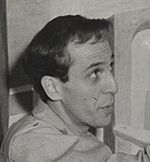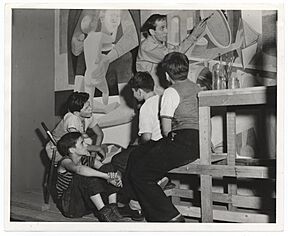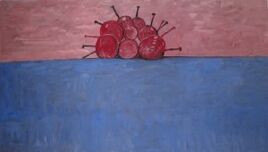Philip Guston facts for kids
Quick facts for kids
Philip Guston
|
|
|---|---|

Guston in 1940
|
|
| Born |
Phillip Goldstein
June 27, 1913 Montreal, Quebec, Canada
|
| Died | June 7, 1980 (aged 66) |
| Nationality | American |
| Education | Los Angeles Manual Arts High School, Otis Art Institute |
| Known for | Painter, graphic artist, muralist, printmaker |
| Style | Cartoon, Abstract |
| Movement | Abstract expressionism, Neoexpressionism, figurative painting, New York School |
| Spouse(s) | Musa McKim |
| Patron(s) | David McKee |
Philip Guston (born Phillip Goldstein, June 27, 1913 – June 7, 1980) was a famous Canadian American artist. He was a painter, printmaker, muralist, and draftsman. Many people consider him one of the most important American painters of the last 100 years.
Guston explored many art styles. He painted about important topics like racism, antisemitism, and fascism. He also looked at what it means to be American. Later in his career, he used a cartoon-like style to show the everyday nature of evil. In 2013, his painting To Fellini sold for a record $25.8 million at an auction.
Guston was a key artist in the New York School in the mid-1900s. This group helped make New York a major center for art around the world. By the 1960s, Guston changed his style. He moved away from abstract art and helped start a new style called neo-expressionism. He began painting in a dark, story-telling way. He even made drawings of Richard Nixon during the Vietnam War. He also painted figures wearing hoods, like those of the KKK. Guston said these hooded figures were like self-portraits. He explained that he felt like he was "behind the hood" and was fascinated by the idea of evil.
In 2020, a major art show featuring Guston's work was planned. It was going to travel to top museums like the National Gallery of Art and the Tate Modern. However, the museums decided to delay the show until 2024. They said they wanted to make sure the strong message of social justice in Guston's work could be understood clearly. This delay caused many artists to speak out. They felt the museums were not brave enough to show Guston's art. They argued that Guston's KKK themes were important for discussing white supremacy today. The museums later announced earlier dates for the exhibition, starting in 2022.
Contents
Philip Guston's Life Story
Early Years and Art Education
Philip Guston was born in Montreal, Canada, in 1913. His parents were Ukrainian Jewish and had moved from Odessa to escape persecution. In 1919, his family moved to Los Angeles. They knew about the Ku Klux Klan's activities against Jewish and Black people in California. In 1923, when Philip was ten, his father passed away.
Philip loved to draw. His mother enrolled him in a cartooning course. At 14, in 1927, he started painting. He went to Manual Arts High School in Los Angeles. There, he met Jackson Pollock, who became a lifelong friend. They learned about European modern art and Eastern philosophy. They even wrote a paper against the school's focus on sports over art. This led to them being expelled, though Pollock later returned.
Guston mostly taught himself art. He had a short scholarship at the Otis Art Institute but found it unhelpful. He was inspired by artists like Giorgio de Chirico. Philip Guston passed away in 1980 in Woodstock, New York, at age 66.
Guston's Artwork and Styles
Early Political Murals
When he was 18, in 1932, Guston was an activist. He created a mural with artist Reuben Kadish. This mural helped raise money for the "Scottsboro Boys Trial." In this trial, nine Black teenagers were wrongly accused in Alabama. Local police groups, known as "Red Squads," damaged the mural.
In 1934, Guston and Kadish traveled to Mexico. They painted a large mural called The Struggle Against Terror. This mural showed strong anti-fascist ideas. It also included the hooded figures that Guston would use throughout his career to represent prejudice. The famous artist David Siqueiros called them "the most promising painters." In Mexico, Guston also met artists Frida Kahlo and Diego Rivera.
Guston and Kadish also painted a mural at the City of Hope National Medical Center in California. This was a hospital for tuberculosis patients at the time.
Art for the WPA Program
In 1935, Guston moved to New York. He worked as an artist for the WPA program. This program helped artists during the Great Depression. In 1937, he married artist and poet Musa McKim. They worked together on several WPA murals. During this time, Guston was influenced by Renaissance painters like Piero della Francesca. He also looked at American and Mexican mural artists. He painted murals for post offices and government buildings.
Abstract Expressionism Art Style
In the 1950s, Guston became well-known for his abstract expressionism. He preferred to call it the "New York School." His paintings from this time often had blocks of color and brushstrokes floating in the middle. An example is his painting Zone from 1953–1954. These works used a limited range of colors, mostly black, white, grays, blues, and reds.
Developing Neoexpressionism
In 1967, Guston moved to Woodstock, New York. He was growing tired of abstract art. He started painting pictures again, but in a very personal, cartoon-like way. This change surprised many people in the art world. Some thought he had lost his mind.
His first show of these new paintings was in 1970. Art critics gave it very bad reviews. One critic called his new style "Ku Klux Komix." However, some artists, like Willem de Kooning, understood his new work. De Kooning told Guston that his paintings were "about freedom." Cherries III from 1976 is an example of his later work. Even simple subjects like cherries could represent the harshness of modern life.
Because of the negative reactions, Guston became more isolated. He created a set of images that he used often. These included Klansmen, light bulbs, shoes, cigarettes, and clocks. In 2009, a show displayed 49 small oil paintings from this period that had never been seen before.
Philip Guston's Legacy
Where to See His Art
Guston's art is in many public collections around the world, including:
- Art Institute of Chicago
- Detroit Institute of Arts
- Honolulu Museum of Art
- Metropolitan Museum of Art
- Museum of Modern Art (MoMA)
- National Gallery of Art
- Tate Modern
In 2022, Guston's daughter, Musa Mayer, gave over 200 of his paintings and drawings to the Metropolitan Museum of Art. This is the largest collection of his work held by one museum.
Teaching and Influence
Guston was also a teacher at many universities. He was an artist-in-residence at the University of Iowa School of Art and Art History from 1941 to 1945. He also taught at Washington University in St. Louis and Pratt Institute in Brooklyn. From 1973 to 1978, he led a monthly seminar at Boston University.
Some of his students became well-known artists themselves, such as Stephen Greene and Gary Komarin. After his death, he was also chosen as an Associate Academician for the National Academy of Design.
Auction Record
In May 2013, Philip Guston's painting To Fellini sold for a record US$25.8 million at an auction.
See also
 In Spanish: Philip Guston para niños
In Spanish: Philip Guston para niños
- Boston Expressionism
- Max Beckmann
- Morton Feldman – a composer who was inspired by Guston's art
- Red Grooms
- Claes Oldenburg
- Jean Dubuffet






